We celebrate 50 years of Lasers on the Naked Scientists this week, by looking into the history, and future, of laser science. We'll hear how lasers have revolutionised manufacturing and could be the answer to our clean energy concerns. Also, how lasers make the most accurate measurements for high precision industries, and how laser tweezers can be used to manipulate things smaller than a red blood cell, and make tiny tools. In Kitchen Science, Dave launches his bid for world domination by building a home-made laser! Plus, how sharks sniff out a snack, the technology that keeps world cup matches safe and accessible, and how the Deepwater Horizon oil spill will affect Louisiana's wetlands.
In this episode
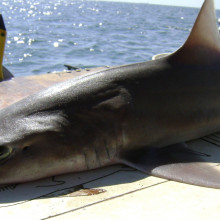
01:39 - How Sharks Sniff out a Snack
How Sharks Sniff out a Snack
Sharks are known for their ability to follow a scent in the water to their next meal - and now researchers in Florida have discovered how they do it.
Writing in Current Biology, Jayne Gardiner at the University of South Florida and Jelle Atema at Woods Hole Oceanographic Institute showed that sharks are able to detect very small delays in a scent reaching each nostril - and it's this, rather than the actual concentration of the chemical, that gives them their sense of direction.
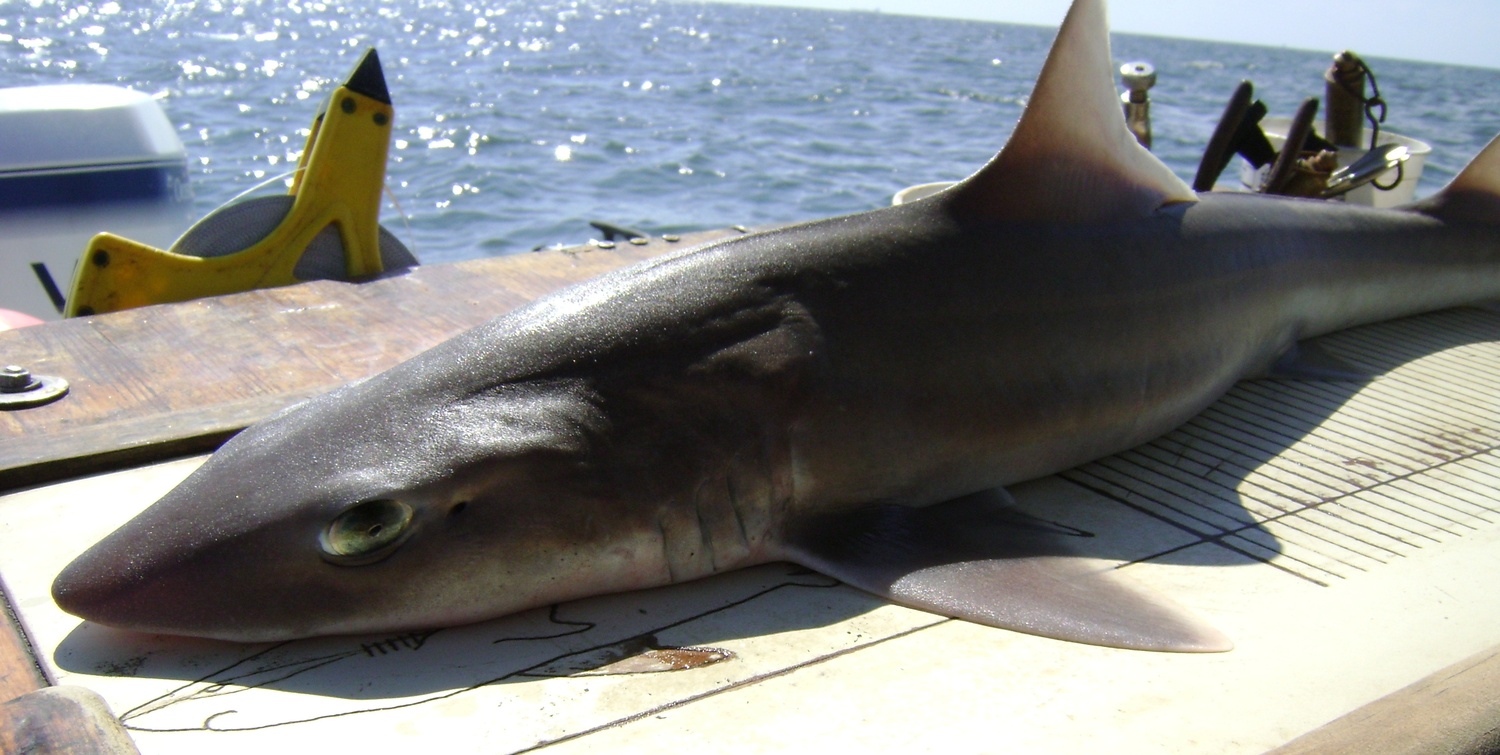 Most species that rely on scent are equipped with stereo sensors - 2 antennae on an insect or 2 nostrils on a dog for example. It's long been assumed that this means species can home in on the source of a scent using the concentration as a guide - if the scent is stronger on the left than the right, they simply turn 'into' the concentration gradient.
Most species that rely on scent are equipped with stereo sensors - 2 antennae on an insect or 2 nostrils on a dog for example. It's long been assumed that this means species can home in on the source of a scent using the concentration as a guide - if the scent is stronger on the left than the right, they simply turn 'into' the concentration gradient.
In reality, concentration gradients are rarely, if ever, that simple. When dispersed in air or water, chemicals are very unlikely to form a uniform gradient - instead existing in whirls or vortices, with peaks of concentration sometimes a long way from the source. This means that following a concentration gradient alone is likely to lead you in circles - not an efficient way to hunt.
Working with the smooth dog shark, Mustelus canis, the researchers introduced a scent to each nostril in controlled concentrations and with controlled time delays. They found that the timing of the pulses was most important, as the sharks would turn towards the first pulse, even if the second was of higher concentration. This seemed to break down when the delay was too large - over one second and the shark was just as likely to turn either way. This means that the sharks will weave from one side to the other, following the average concentration gradient without being waylaid by the small local concentration changes.
The researchers now want to follow this up, and see if wider spaced nostrils give a shark greater accuracy at higher speeds. Hammerhead sharks, with their distinctive flattened heads known as cephalofoils, have much greater separation between nostrils, so even though their olfactory organs are just as sensitive as other sharks, they may be better able to detect these time differences, and so hunt more efficiently.
This finding also has some very interesting other applications - it can be applied to underwater steering algorithms to allow unmanned robotic craft to quickly locate the source of a chemical, such as an oil leak, underwater.
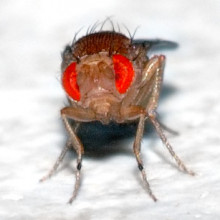
05:01 - Eat or sleep?
Eat or sleep?
It's the Homer Simpson dilemma - is it more important to eat or to sleep? If mammals are deprived of sleep, then they want to eat more to help stay awake, and being deprived of food, through starvation, keeps them awake - presumably to search for more food. But we don't know a lot about how this is controlled. Obviously, we need to strike the balance with enough of both, though you can combine them - I had a dream I was eating a giant marshmallow, and when I woke up my pillow had vanished!
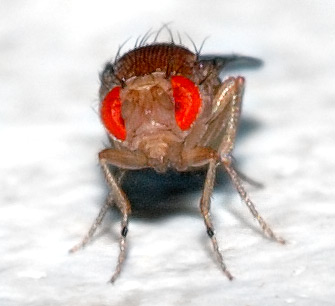 Anyway, now researchers in the US have uncovered some of the genes that control this balance in fruit flies, which may shed light on our own patterns of eating and sleeping.
Anyway, now researchers in the US have uncovered some of the genes that control this balance in fruit flies, which may shed light on our own patterns of eating and sleeping.
This is work from Alex Keene and his colleagues, published this week in the journal Current Biology. They've been looking at the sleeping and feeding cycles of tiny fruit flies, known as Drosophila. These are quite a handy model organism for this kind of study, as we know a lot about their daily rhythms, known as circadian rhythms.
The scientists discovered that starving fruit flies had a powerful effect on keeping them awake, the same as in mammals. And given that fruit flies share a lot of genes with humans and other mammals, this suggests that we might be able to unpick the genetic connections between sleeping and feeding using these little flies.
The scientists scanned through 2,000 genes in the flies, and found over a dozen that were involved in sleeping and feeding. Then they narrowed down their search to just two, called Clock and Cycle, which are also involved in flies' daily rhythms - they're also involved in daily rhythms in mammals, including humans. To find out more about the role of these genes, they looked at flies both with and without each gene, under starvation conditions, to find out how much they slept.
But how can you tell if a fly is sleeping or not? Well, the researchers monitored the flies' movements - if a fly isn't moving regularly, it's a pretty good bet it's asleep.
The scientists discovered that flies missing the Clock and Cycle genes had a three to four-fold reduction in sleep when they were starved, compared with genetically normal flies. This tells us that both the genes play an important role in helping the flies to sleep under starvation conditions, and probably help to co-ordinate the choice between sleeping and eating at any given time.
Because the clock and cycle genes are also found in humans, and have very similar roles, it may be that these genes also help us to co-ordinate eating and sleeping too. So further research with mammalian models and human cells might shed light on how to treat sleep disorders and metabolic and eating problems. But at the moment, this is just speculation, and more work needs to be done.
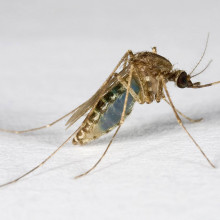
08:25 - Honey Trap to Detect Mosquito Pathogens
Honey Trap to Detect Mosquito Pathogens
Collecting mosquito saliva in honey can help to track the pathogens they carry, according to researchers in Australia.
Andrew Van Den Hurk at the University of Queensland and colleagues have published a report in the journal PNAS detailing how mosquitoes can be coaxed into leaving saliva samples in honey soaked cards. These cards can then be analysed to find any virus RNA present, giving you a precise guide to what viruses local mosquitoes are carrying, without ever having to handle a mosquito.
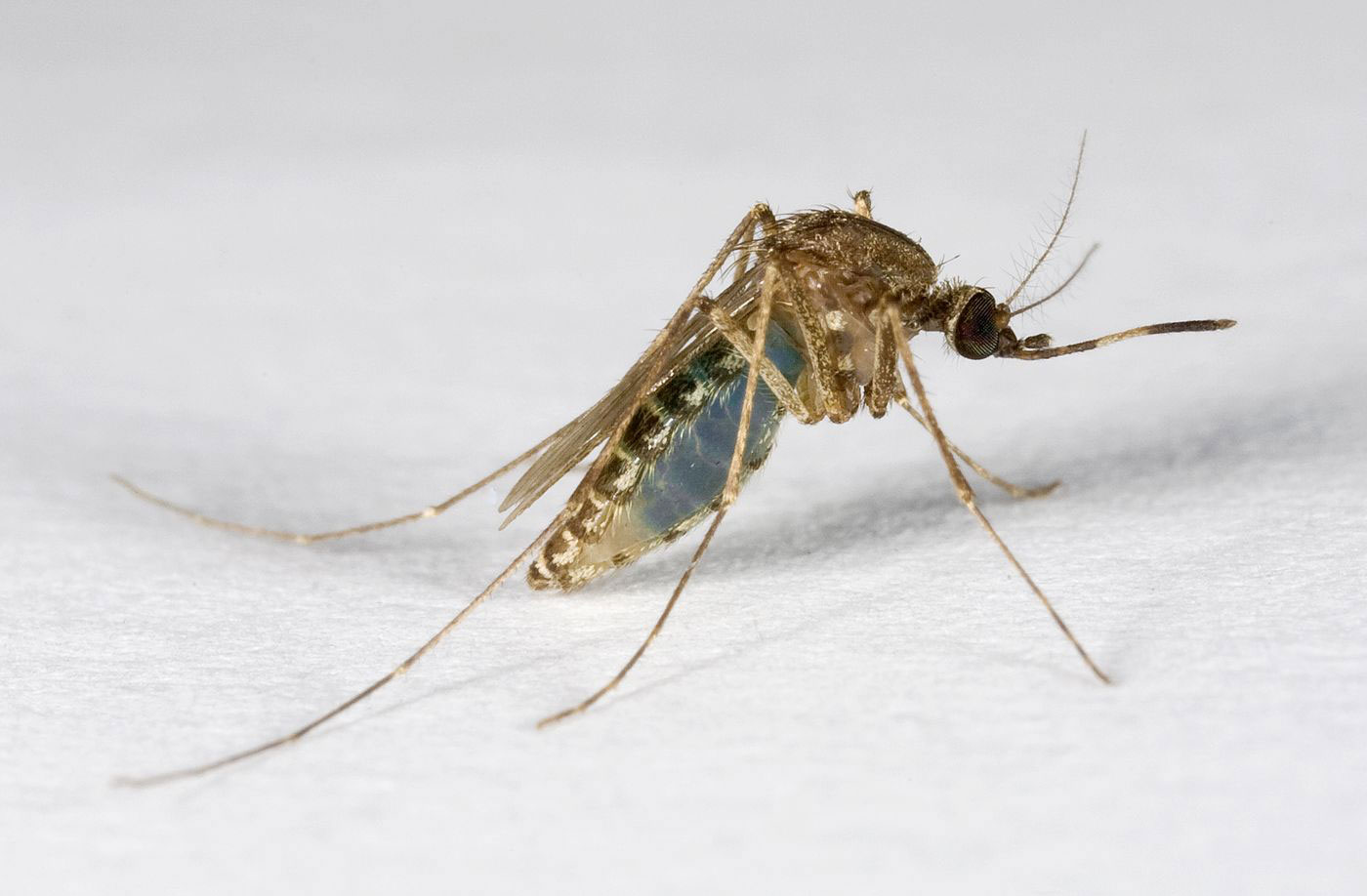 Arthropod-borne viruses, or arboviruses, are a global public health problem, and include things like Dengue, yellow fever and West Nile virus. Proper surveillance of these viruses is essential for disease control strategies such as vaccination, but present mosquito-based survey techniques are "expensive and logistically problematic" - involving collection and transport of live mosquitoes. Other survey methods involve disease diagnosis in infected patients or monitoring "sentinel" animals.
Arthropod-borne viruses, or arboviruses, are a global public health problem, and include things like Dengue, yellow fever and West Nile virus. Proper surveillance of these viruses is essential for disease control strategies such as vaccination, but present mosquito-based survey techniques are "expensive and logistically problematic" - involving collection and transport of live mosquitoes. Other survey methods involve disease diagnosis in infected patients or monitoring "sentinel" animals.
The honey trap method has several advantages. The honey soaked cards preserve viral RNA for at least seven days without refrigeration - even when tested in both temperate conditions (at a site near Bunbury in Western Australia) and tropical conditions (near the Northern Queensland city of Cairns).
The honey itself is an important part of the process, as it remains moist throughout the collection period - ensuring the mosquitoes have access to the liquid sugars that they find very attractive. Manuka honey also has antibacterial properties which help to protect viral RNA from bacterial RNAases, preserving the sample for long enough to be analysed.
In lab tests, by adding blue dye to the honey, the researchers could identify which mosquitoes had been feeding, and then compare evidence of virus on the card to traditional saliva samples - showing this method to be of similar or better accuracy to the traditional, more time consuming sampling methods. In fact, some virus particles were transmitted even without the mosquitoes consuming any honey, as an infected mosquito just probing a food source is enough to transmit a virus to a susceptible host.
This report shows that this novel technique works for Ross River virus, Barmah Forest virus, Chickungunya and West Nile virus, but the authors suggest that it could be expanded to detect malaria, or used with other virus vector species.
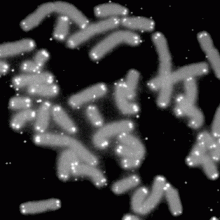
11:39 - DNA ends could hold key to leukaemia
DNA ends could hold key to leukaemia
Cancer is a disease that starts when cells become immortal and multiply out of control. Over the years, researchers have discovered that a crucial part in the process - for at least 8 out of 10 cancers - is the switching on of telomerase, a protein that makes telomeres, the 'caps' on the ends of our chromosomes (a bit like the plastic caps on the ends of shoelaces).
 Without telomerase, our telomeres get shorter and shorter, and eventually - when they get too short - the cell stops dividing. It's a bit like a molecular clock, counting down the lifetime of our cells. But cancer cells switch telomerase back on, so they can just keep multiplying.
Without telomerase, our telomeres get shorter and shorter, and eventually - when they get too short - the cell stops dividing. It's a bit like a molecular clock, counting down the lifetime of our cells. But cancer cells switch telomerase back on, so they can just keep multiplying.
Now new research from scientists in Cardiff, funded by the charities Cancer Research UK and Leukaemia & Lymphoma Research, have discovered that a certain type of leukaemia may actually develop as a result of telomerase not being active enough.
Led by Dr Duncan Baird, the scientists were studying samples from patients with chronic lymphocytic leukaemia, or CLL for short - this is a cancer that affects white blood cells, which multiply out of control. Writing in the journal Blood, the scientists used a new technique to precisely measure the lengths of telomeres in the cancer cells, and compared them to telomere lengths in blood cells from people without the disease.
They found that telomerase appears to be underactive in the cancer cells at the early stages of the disease, so the telomeres get shorter and shorter. At this point, you would expect the cells to stop dividing and die, but they don't.
Instead, the ends of the chromosomes start to stick together, causing strange genetic alterations that further fuel the development of cancer. But then the researchers think that telomerase get switched on at this point, immortalising the genetically weird cells, and fuelling the growth of cancer.
This is the first time that this process has been shown to happen in human cancer cells, so it's pretty important stuff. What's more, the research could potentially lead to a blood test for monitoring how fast leukaemia is progressing, by measuring telomere length, as well as helping doctors to decide on the best treatment, or speeding diagnosis.
Scientists are now trying to find out if this is involved in other cancers - they're looking at telomere length in other types of tumour, such as bowel cancer. At the moment, we don't have any results from this work. But if they find similar mechanisms at work, it could open up an exciting new avenue of research, which could lead to future cancer treatments or diagnostic techniques.
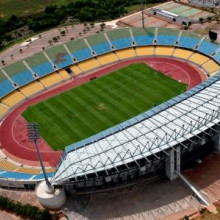
14:40 - World Cup Technology
World Cup Technology
with Kelvin Kemm, Pretoria, South Africa
Meera - This week saw an historic moment in football, the kick-off of the First World Cup ever to be held in an African nation. I spoke to Kelvin Kemm from Pretoria in South Africa to find out what things are like over there and how science and technology is being used to make sure the games are as safe and accessible to as many people as possible in South Africa.
Kelvin - Well Meera, everybody's going World Cup mad here. On large TV masts and 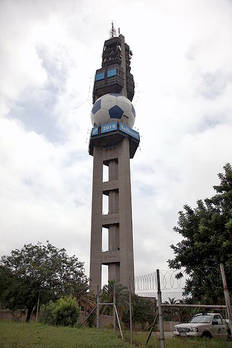 the cell phone masts there's huge soccer balls on the masts there. Everybody's got soccer balls all over the place. On every placard you can imagine there are soccer pictures. All the teams are arriving day by day and every team has been met at the airport and wave down the street. Everybody is riding around with flags out of their car windows, so you can't look anywhere now that there isn't soccer fever all over the place.
the cell phone masts there's huge soccer balls on the masts there. Everybody's got soccer balls all over the place. On every placard you can imagine there are soccer pictures. All the teams are arriving day by day and every team has been met at the airport and wave down the street. Everybody is riding around with flags out of their car windows, so you can't look anywhere now that there isn't soccer fever all over the place.
Meera - And have there been any particular science or technological developments in relation to the World Cup, say to help people watch it or even for security reasons?
Kelvin - There's been some interesting things. For example, one company has taken a number of solar powered television sets into far remote areas that are not electrified, so all our local villagers can to come along and sit and watch the World Cup on TV. Also, something else interesting is about the security as you mentioned. There's huge security coverage. For example, if a model airplane takes off, a radio controlled plane, and aims towards the stadium, the military and security command centre can detect that model airplane and crash it - if it goes on a path towards our soccer stadium. By radio jamming, they will jam the radio signals so the aircraft crashes.
And even base jumpers - every base jumper has got to be registered and can't jump within a certain radius of a stadium unless they get permission, which they won't get during a game.
 But large and small aircraft as well, every single aircraft from a small private airplane to the Boeing 747s has got to ask permission to cross a 100 kilometre radius around the game, every single time they cross, and we're talking about thousands of occasions. Each one has to be individually certified, and the planes all have to register beforehand so they know exactly who owns the aircraft and what it's doing. So any strange aircraft will be stopped.
But large and small aircraft as well, every single aircraft from a small private airplane to the Boeing 747s has got to ask permission to cross a 100 kilometre radius around the game, every single time they cross, and we're talking about thousands of occasions. Each one has to be individually certified, and the planes all have to register beforehand so they know exactly who owns the aircraft and what it's doing. So any strange aircraft will be stopped.
Something else too which the world can look forward to is the massive television coverage there is going to be - each stadium has got something like 32 cameras per game operated through a giant television coverage centre that has been specifically put aside for the soccer only. So it'll run 24 hours a day just sending TV all over the world. It'll be the largest international television traffic that's ever been sent out of South Africa is the coverage of the soccer.
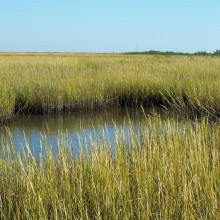
17:40 - Evaluating the Impact of Oil on Louisiana's Wetlands
Evaluating the Impact of Oil on Louisiana's Wetlands
with Dr Robinson Fulweiler, University of Boston
Ben - As well as blanket football coverage, it's been very hard to miss news about the oil leak in the Gulf of Mexico. Estimates vary widely but it's thought that millions of gallons of oil have leaked into the ocean. But what impact will this have on the local environment? Dr. Robinson Fulweiler is a researcher at Boston University where she studies the wetland ecosystems such as those in Louisiana that are likely to bear the brunt of the oil damage. Robinson, thank you so much for joining us. First of all, what are the environments that you're looking at and what do they normally look like?
 Robinson - We're particularly interested in the wetland environments. So these are sort of the grassy vegetative areas and they have lots of different types of vegetation both wetland grasses but mangroves as well, so they're very dynamic systems. Normally, we expect them this time of year to be growing a lot. There's lots of new shoots, so lots of bright green coming out. And of course, these environments are filled with lots of different animals, so a variety of birds, and fish, and snails, all different things.
Robinson - We're particularly interested in the wetland environments. So these are sort of the grassy vegetative areas and they have lots of different types of vegetation both wetland grasses but mangroves as well, so they're very dynamic systems. Normally, we expect them this time of year to be growing a lot. There's lots of new shoots, so lots of bright green coming out. And of course, these environments are filled with lots of different animals, so a variety of birds, and fish, and snails, all different things.
Ben - Okay, so quite a biodiverse area actually.
Robinson - Absolutely.
Ben - How do you go in there and assess an ecological impact of an event like an oil spill?
Robinson - That's a really good question and I think it's going to be a challenging one to answer. So, the first is that Louisiana's ecosystem - wetland ecosystems have really been studied for a long period of time. So we've got a lot of historical data from before the oil spill. Now, we're all about going in and trying to find areas that have been impacted and starting to measure certain things to see how is it changed from after the oil spill? So we collect samples and then bring them back to the lab for analysis.
Ben - And what sort of damage have we actually seen so far?
Robinson - It's tough to say. So in some cases, it's really obvious. When you pull the boat up on shore, you can see that the wetland grasses, their shoots are covered in the oil, and just to give you an idea of what that oil is like, it's kind of like when you make a sundae, it's got that caramel - melted caramel and hot chocolate. It's got that kind of texture to it, so it's really thick and gooey, sticky.
Ben - You're making it sound very appealing whereas I've imagined, oil isn't so nice.
Robinson - It's not delicious. You don't want to eat it. But it's just that's the only way I can describe how sticky it is. So it's covering a lot of the shoots of the grasses. You can see it on some of the animals themselves. Of course, you've seen those pictures of many of the birds and stuff, but when you go into the wetland, you can see it even on crabs and snails, and all over the plants. We even saw some dolphins that had it on their fin and that kind of thing.
At this point, we know that it's definitely coating the organisms and it's also coating the sediment layer, and I'm very interested in some of the organisms that you can't see, the microbial community and we know now that that oil is simply making a lid over all of the sediments and the grasses, and that's what we're trying to figure out how that will impact the system.
Ben - So what do we think can be done to remedy the damage that we've seen?
Robinson - That's another really tough question. There's actually been this great YouTube video that Irv Mendelssohn made and he's from Louisiana State University, so people could Google it, but he sits down and goes over all of the different ways we could try to remedy this situation, and there's probably three most common ways.
One is - and you've probably seen this on the news too - you can burn the oil off and they've been doing this in the open water. You could do that on the wetland too as long as there was a layer of water. So you'd burn that growing vegetation now, but you'd also get the oil off the land and if the oil hasn't seeped into the sediment, the roots should be able to regenerate and grow again. So you could do that.
Another thing is to add nutrients and if you could add things like nitrogen and phosphorus, you can stimulate the biological activity of the wetland and help the microbial community break down the oil.
And then probably the third way is just to sort of let it take its course and over time, the thought is that over time, the oil will start to degrade and go away.
Ben - Okay, so none of them are an immediate fix of course, but why are these environments so important to us? We've discussed the fact that there's a great deal of biodiversity, but wetlands are also very important for the local people living there. But also on a countrywide scale, wetlands are vitally important.
Robinson - Sure. I mean, this is really a major cultural, natural, and economical piece of land here for the United States and I think really for the world as a whole. The wetlands are important for a lot of the fish species that we like to eat, so the commercial species that are good. Then of course, they're important for birds and lots of nursery habitats.
But they're also important for things that we tend not to think too much about like the filtering of nutrients. So they can act as a filter to remove things like nitrogen and phosphorus that humans put into the environment. And so, that's kind of an ecosystem service that maybe it goes overlooked and is really important, and we imagine that putting the oil on these wetlands will change how they filter nutrients.
Ben - So it could have slightly longer term and more economic impacts than we actually thought. Robinson, thank you ever so much for joining us. That was Dr. Robinson Fulweiler from Boston University. She's been down to Louisiana to assess the ecological impact of the Gulf of Mexico oil spill.
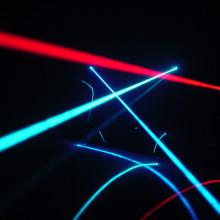
23:20 - 50 Years of Lasers
50 Years of Lasers
with Dr Graeme Hirst, STFC's Central Laser Facility
Kat - This week, we are celebrating 50 years of the laser and to fill us in on the background of the laser and some of the cutting edge applications and research that's currently going on, we're joined by Dr. Graeme Hirst and he's the head of laser application at the STFC's Central Laser Facility. Hi, Graeme.
Graeme - Hello there, Kat.
Kat - Let's start off by asking the question, what is a laser? What is a laser and how does it work?
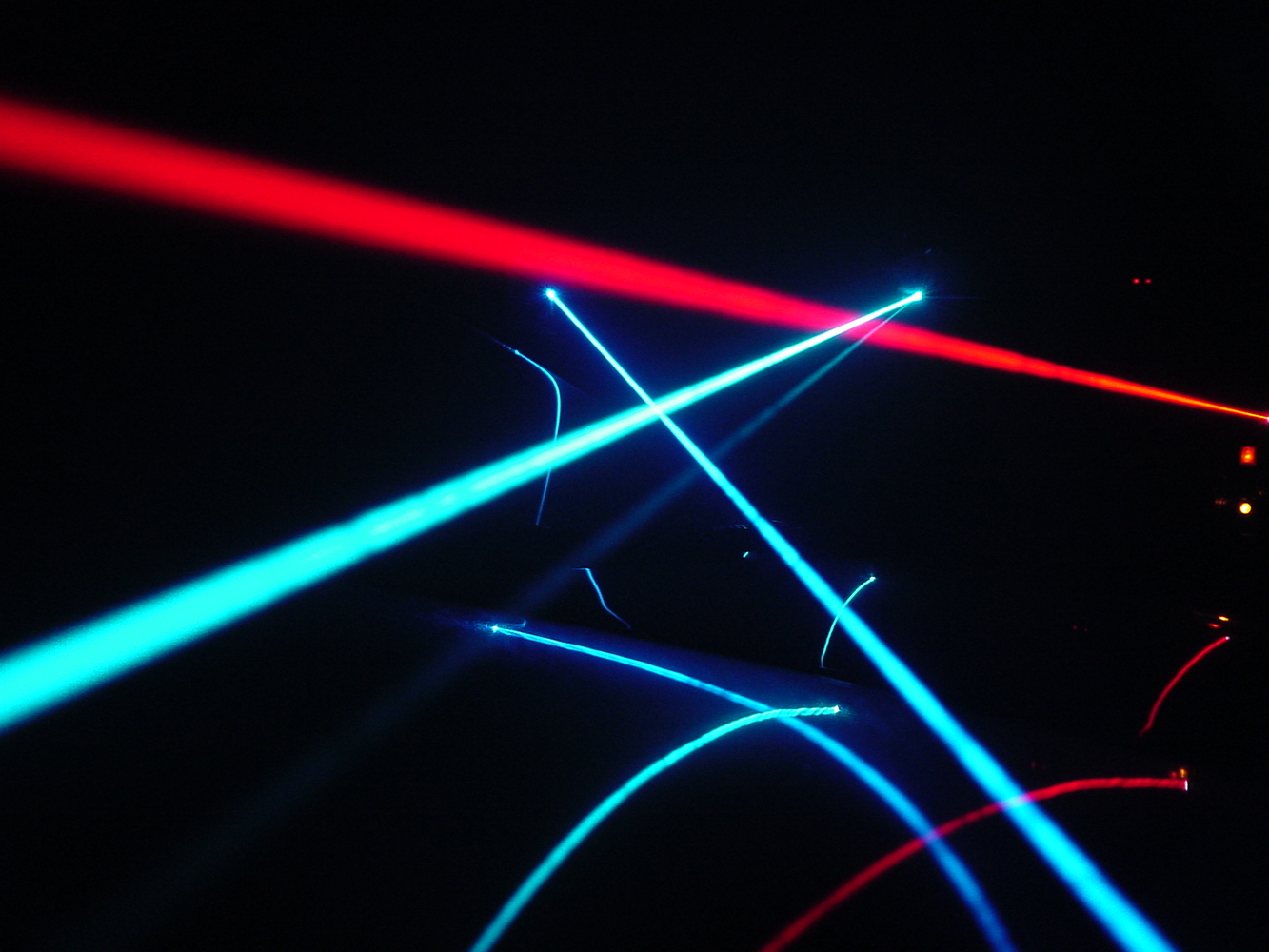 Graeme - Well I think most of us have an idea of what one of these things looks like. It's a small box out of which comes out a very bright beam of light and I guess what you want to know is what's inside. The word LASER stands for Light Amplification by Stimulated Emission of Radiation. So what's inside there is an amplifier. It's a device where you put a little bit of light in and you get a lot more light out. And usually, that comes in three parts. So there will be some stuff which does the amplifying, some material. There'll be a sort of power to pump that stuff to keep it in an excited state where it's capable of amplifying and there will usually be an arrangement of mirrors, and what the mirrors do is take control of the beams. Instead of the light coming out in all directions, in an uncontrolled way, you get that nice pencil-like beam out of the end.
Graeme - Well I think most of us have an idea of what one of these things looks like. It's a small box out of which comes out a very bright beam of light and I guess what you want to know is what's inside. The word LASER stands for Light Amplification by Stimulated Emission of Radiation. So what's inside there is an amplifier. It's a device where you put a little bit of light in and you get a lot more light out. And usually, that comes in three parts. So there will be some stuff which does the amplifying, some material. There'll be a sort of power to pump that stuff to keep it in an excited state where it's capable of amplifying and there will usually be an arrangement of mirrors, and what the mirrors do is take control of the beams. Instead of the light coming out in all directions, in an uncontrolled way, you get that nice pencil-like beam out of the end.
Kat - So you got a very intense beam of light that can really be controlled in a very precise way. What sort of frequencies of light can we use? We've had a question in from Klvn8r on Twitter who says, "Can a laser light be from anywhere in the spectrum of light?"
Graeme - These days they can, yes. The very first laser that was produced worked in the near infrared. It was really, really bright, so you could probably see it, but only just about. Gradually, as time went on, more and more lasers were developed with a wider range of available colours - a wider range of available wavelengths. And these days, the range is spectacular. Just last year, a group of scientists in America demonstrated a really high power laser that's actually working in the x-ray region.
Kat - That's pretty powerful, I should imagine...
Graeme - A very scary thing, yes.
Kat - Lasers have been around for about 50 years. What was the background of lasers? I've heard them described as a technology looking for an application. How were they first invented?
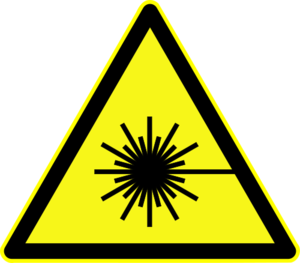 Graeme - Yup! Solution looking for a problem. They grew from a background research on microwave amplifiers, which if you like is a sort of very short wavelength radio wave, and as the wavelength got shorter and shorter - and light, if you like is just a different kind of electromagnetic radiation - There was race on it to be the first one that you could see, essentially. And Ted Maiman generated this ruby laser back in 1960, 50 years ago, the first laser you could see, and he won the prize. Since then, the applications have just spread out enormously. To begin with they were a very useful research tool, but pretty quickly, people got the hang of the fact that you could cut and weld with these and you'll remember the James Bond film Goldfinger where cutting and welding was very much to the full.
Graeme - Yup! Solution looking for a problem. They grew from a background research on microwave amplifiers, which if you like is a sort of very short wavelength radio wave, and as the wavelength got shorter and shorter - and light, if you like is just a different kind of electromagnetic radiation - There was race on it to be the first one that you could see, essentially. And Ted Maiman generated this ruby laser back in 1960, 50 years ago, the first laser you could see, and he won the prize. Since then, the applications have just spread out enormously. To begin with they were a very useful research tool, but pretty quickly, people got the hang of the fact that you could cut and weld with these and you'll remember the James Bond film Goldfinger where cutting and welding was very much to the full.
Kat - Absolutely. We do seem to see so many applications - from laser light shows at pop concerts, if you follow fashion laser cut shoes are very in at the moment, you can have laser surgery on your eyes, and presumably, a whole host of very technical applications. What's the sort of diversity that lasers are used for nowadays?
Graeme - Just about everything. Look around your house, you'd be surprised how many things have been made by a laser. Pretty well all the silicon chips, your flat panel TVs, as you say, a lot of stuff's been cut. We're working on quite a range of applications here. Everything from using lasers to look inside blister packs that have tablets in, just to make sure that the tablet really is what it says on the outside of the box, all the way through to trying - as you mentioned in the intro, to sought out the world's energy crisis. What are we going to do when we can't use fossil fuels anymore?
Kat - So how can we use lasers to make energy?
Graeme - Well if you think about fossil fuels, what they are is they're essentially stored sunshine. Almost all of the energy that we use on the earth now started at a sunshine and the process, the natural process that drives sunshine is called fusion. The idea is to use high power lasers to get that fusion process under control here on the surface of the earth. Then you can take isotopes of hydrogen, you can glue them together in the fusion process, you can make helium, and you release energy. And that's the way the sun works and that's the way we would like to do it.
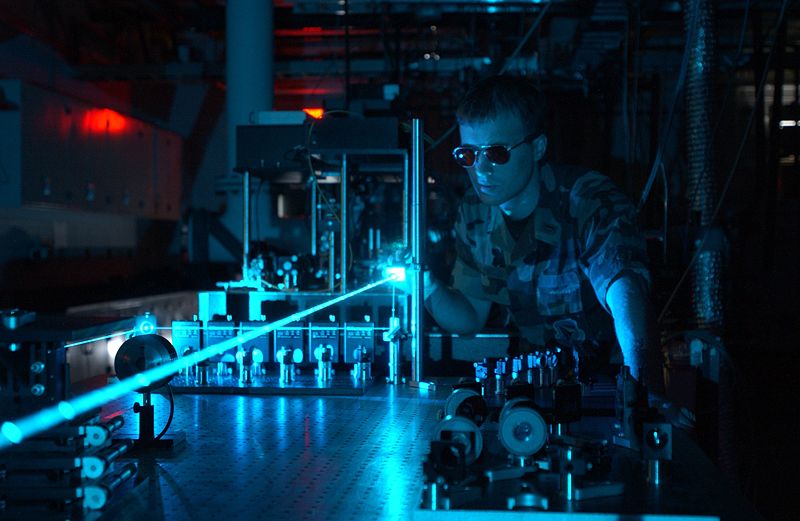 Kat - And we've had a question in here from Paul Anderson who's in New Zealand who says, "if you're using solar rays in the dessert, it would take enormous cables, very expensive cables to transmit the electricity, but could we convert the energy into a laser beam? You could bounce it off a satellite back to Europe. You won't need cables at all." Could we transmit electricity by laser light?
Kat - And we've had a question in here from Paul Anderson who's in New Zealand who says, "if you're using solar rays in the dessert, it would take enormous cables, very expensive cables to transmit the electricity, but could we convert the energy into a laser beam? You could bounce it off a satellite back to Europe. You won't need cables at all." Could we transmit electricity by laser light?
Graeme - It is an interesting thought. Yes, and in principle you can. People have looked at it for a number of applications. One is, can you use it to power that satellite? Satellite power is a tough challenge, and yes, in principle, it can be made to work, but there are issues, obviously. You'd have to decide how you're going to keep people you wanted out of the way, out of the way of the beam. It's kind of an unwritten rule that you never point a laser at anything you don't intend to do. And so, you would have to ask how you make sure it wouldn't go wrong. You've also got efficiency issues because even now, even with the very best lasers, they're not 100% efficient at converting electricity into light and then converting it back again.
Kat - On the question of "you wouldn't want things in the way", we've had a question in from DavidWhalley94 on Twitter who says, "If you shone two lasers directly into each other, what would happen?"
Graeme - Well that's a good question. If you shone them directly into one another, then you're quite likely to break the lasers unfortunately. But if you imagine you're going to misalign them slightly so that the beams crossed, but they don't go down the throat of the opposing laser, then if you were to do that in a vacuum, if you just have one light beam crossing another then to all intents and purposes, nothing happens. Once you get to extreme physics conditions where the laser intensity does become spectacular - and in some experiments we do, we're getting there - you might imagine that you can perturb the vacuum. You can change the vacuum with the intensity of light you need. But mostly, this is interesting if you cross the two beams over in some kind of material, and if you do that, you can achieve all sorts of interesting effects in the material by combining two laser beams, through the properties of the material.
Kat - I love the idea of extreme physics. Just to return to the sort of applications of lasers, so we can do all these things, we can use them for seeing stuff, we can use them for cutting things. What actually determines the properties of an individual laser? How can you change them, tweak them?
Graeme - Well, if for instance you wanted to change the colour of the laser beam, then you're going to have to change the stuff that's doing stimulated emission. And in the past, we've used everything from liquid dyes, to solid crystals, to gases. You can get a whole range of different colours that way. If you want to change the properties of the beam itself, if you want to focus it down or blow it up or propagated it a long distance then you would change the mirrors. You would alter the optics or you would put other mirrors in.
Kat - So basically, it is just pretty much anything you can do with lasers. Is there anything lasers can't do that we'd like them to do?
Gaeme - There are quite a few. We're still working not only on finding new applications for lasers, but there's still a lot of work on "the better laser". And as I say, it was dramatic results recently in the states, pushing the laser wavelength down into the very short part of the spectrum.
Kat - What could you do with an x-ray laser?
Gaeme - What can you do? Well you can do all the things that you can do with an x-ray light source, only a million or 10 million or 100 million times more quickly or faster. So for instance, they were using them for attempting x-ray imaging, they were trying to probe x-ray signatures of elements. There's a whole range of science that would've taken weeks that can now be done in seconds.
Can a laser be any spectrum of light?
We put this question to Dr Graeme Hirst, from the STFC's Central Laser Facility...
Graeme - These days they can, yes. The very first laser that was produced worked in the near infrared. It was really, really bright, so you could probably see it, but only just about. Gradually, as time went on, more and more lasers were developed with a wider range of available colours - a wider range of available wavelengths. And these days, the range is spectacular. Just last year, a group of scientists in America demonstrated a really high power laser that's actually working in the x-ray region.
Can we transmit energy via lasers and satellites?
We put this question to Dr Graeme Hirst, from the STFC's Central Laser Facility...
Graeme - It is an interesting thought. Yes, and in principle you can. People have looked at it for a number of applications. One is, can you use it to power that satellite? Satellite power is a tough challenge, and yes, in principle, it can be made to work, but there are issues, obviously. You'd have to decide how you're going to keep people you wanted out of the way, out of the way of the beam. It's kind of an unwritten rule that you never point a laser at anything you don't intend to do. And so, you would have to ask how you make sure it wouldn't go wrong. You've also got efficiency issues because even now, even with the very best lasers, they're not 100% efficient at converting electricity into light and then converting it back again.
If you shone two lasers directly into each other, what would happen?
We put this question to Dr Graeme Hirst, from the STFC's Central Laser Facility...
Graeme - Well that's a good question. If you shone them directly into one another, then you're quite likely to break the lasers unfortunately. But if you imagine you're going to misalign them slightly so that the beams crossed, but they don't go down the throat of the opposing laser, then if you were to do that in a vacuum, if you just have one light beam crossing another then to all intents and purposes, nothing happens. Once you get to extreme physics conditions where the laser intensity does become spectacular - and in some experiments we do, we're getting there - you might imagine that you can perturb the vacuum. You can change the vacuum with the intensity of light you need. But mostly, this is interesting if you cross the two beams over in some kind of material, and if you do that, you can achieve all sorts of interesting effects in the material by combining two laser beams, through the properties of the material.
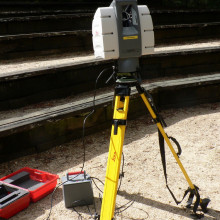
30:51 - Lasers for Measurement
Lasers for Measurement
with Jonathan Williams & Ben Hughes, National Phisical Laboratory
Meera - This week, I've come along to the National Physical Laboratory in Teddington in Middlesex which specialises in the science of measurement, that's metrology, and what's interesting is that lasers play a crucial part in the science taking place here. So here to tell me more about that is Jonathan Williams, leader of the quantum and electromagnetic division.
Jonathan - NPL covers a wide range of measurement for all the physical sciences. What we do is develop specialised techniques to serve a wide range of applications as you mentioned all the way through precision manufacturing, through the measurement of time, through to the measurements for healthcare so that people get the right treatment when they go in for radio therapy in hospitals for example.
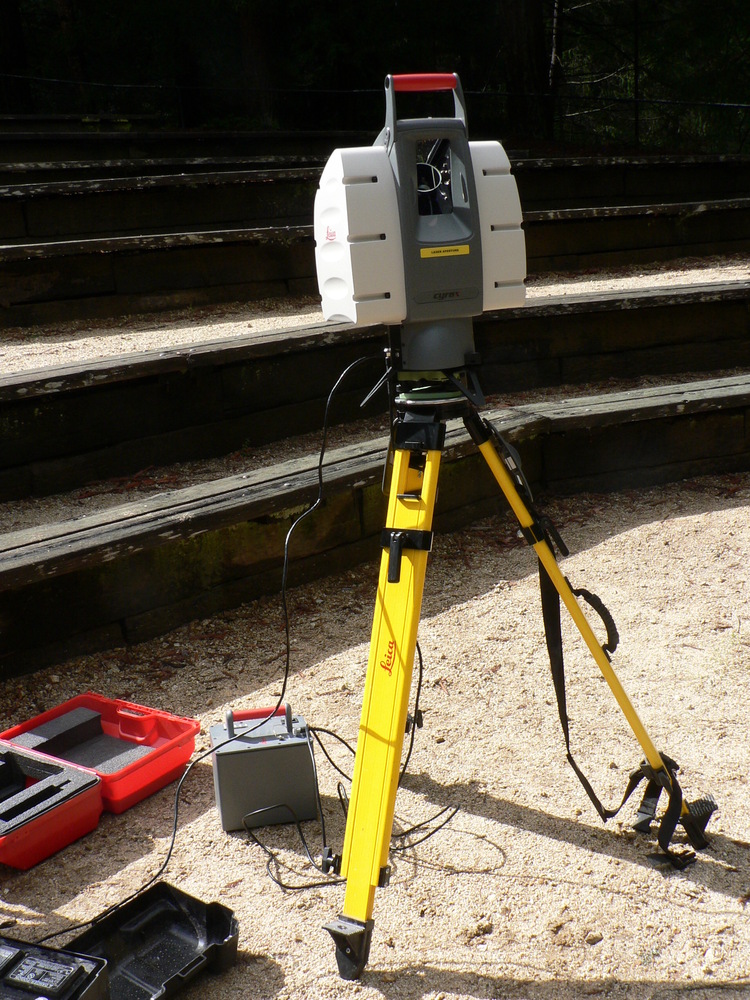 Meera - And how are lasers used here then and how crucial are they to this wide range of science taking place?
Meera - And how are lasers used here then and how crucial are they to this wide range of science taking place?
Jonathan - The principle things for us with the laser is it's highly columnated so it travels in very straight lines and it also can be constructed to have a stable frequency or wavelength, and these are two key aspects that allow us to use metrology. The travelling in straight lines is important because it means you can use it to measure distance, you can also use it to do measurements at a distance. So for example, you can use it to scan the atmosphere and measure the amount of pollutants, say, above an oil refinery. So this is a principle like radar where of course, radar measures things like airplanes using microwaves. The equivalent technique with a laser is called LIDAR and it has two advantages. It can pinpoint where emissions are coming say, from hydrocarbons or sulphur dioxide, and it can tell you how much material is there, and also, exactly where it is in terms of distance and angle. We designed a specific "laser van" we call it, or a LIDAR instrument at NPL and this van drives around the world in fact, and it can then scan right across an oil refinery from within one place, and it has a very complicated suite of lasers inside that are tuned to the exact atmospheric pollutants that you're looking for.
Meera - Now when describing these things, I'm imagining a constant laser beam being used in order to make all of these measurements, but you can also work with lasers in pulses as well.
Jonathan - That's correct. I mean, a lot of people think of a laser as a continuously operating device that it shines all the time. But you can set them up to make very, very short pulses where short is 1 million millionth of a second, the picosecond time scale. And this has a wide range of applications in measurement too. In particular, we use these very short pulses to make short electrical pulses, very tiny impulses of electricity, and then these are used to characterise very fast electronics.
Meera - And what applications does this pulse format of lasers have?
Jonathan - Well the biggest application in which we all benefit from these days is in communications. A lot of communication now is done over optical fibres. Some even into the home, and these systems rely on very short laser pulses to carry the information in a very sophisticated form of Morse code. So what we do in metrology is we have to understand how well these lasers work and what their equivalent bandwidth is, and their reliability.
Meera - So that's a wide range of applications of the laser here and more generally in science, but where can you see then the use of lasers being taken next?
Jonathan - So the future on the science horizon is to use a laser light at very low intensity levels, so small in fact it breaks up into its smallest components, what we call photons, and the possibility there is you can then send single photons as pieces of information and you can do communication in a very secure way where you send your message as a series of one or zero photons. And this has great attraction because in theory, it's an unbreakable system.
---
Meera - When it comes to measurements, a key application of the laser is in length measurement, and with me now, to explain more about this is Ben Hughes who is the principal research scientist in the dimensional measurements group. Ben, something that most of us are probably familiar with is we'll see the surveyor at the side of the road, holding some kind of handheld laser device or the estate agents wondering around properties, measuring the sizes of rooms. So how do these actually work and what are they actually measuring by the use of lasers?
Ben - The handheld device that you've mentioned that an estate agent may be using is based on a time-of-flight measurement and it's based on the principle that distance equal speed times time, and we know the speed of light very accurately. So what we have to do is measure the time it takes for a pulse of light to travel from the device to the wall at the other end of the room, and back again. Now given that the speed of light is very high, 300 million metres per second, it means that say, a round trip to say, a wall that's a metre away will take something like 6 nanoseconds. You need some very fast electronics to be able to time that very short time. You have a measurement resolution of something like 50 millimetres, so that's the kind of precision that these devices are operating at.
Meera - Now that's just one application though of measuring length. We are here in the length lab at NPL and here, you measure things on a much larger scale with a device that we've got here just in front of us which is a laser tracker which can measure things as large as aeroplanes.
Ben - This laser tracker is sending out a thin pencil beam of laser light. Now you can think of that laser light as being a ruler. Now on a conventional ruler, the graduations would be perhaps in millimetre spacing. On this ruler, the graduations are spaced by exactly half the wavelength of the light. Now, on our particular laser, the wavelength is 633 nanometres, that is 0.000633 millimetres. So that means every graduation is half of that which is between 315 and 316 nanometres. Now what we can do with our laser tracker is we can use the laser beam to track a reflecting ball as we move it over our object, and the laser tracker is counting those graduations on a laser beam. So it's getting a very high accuracy measurement of where we're moving our ball.
Meera - And now you have this tracking ball, which is a reflective ball, here in front of us and it's only about an inch and a half in diameter. The actual device where the laser is generated just stays still on a desk. The laser hits this ball and then stays basically on this ball, so as the ball moves around, it keeps attracting the laser to it.
Ben - Yes and it has effectively a sensor inside the tracking head which can see where the ball is and can steer the laser beam to follow the ball at all times.
Meera - Just in front of us, there's a metal block and so, if you wanted to accurately measure the height of this, you would just place this reflective ball at the bottom of it then on the top of it, and then you would know what that distance is.
Ben - That's right. At each of those two points, I would measure the coordinates of the ball and then from the coordinates of those two points I can work out the height.
Meera - So how is it applied to the aviation industry?
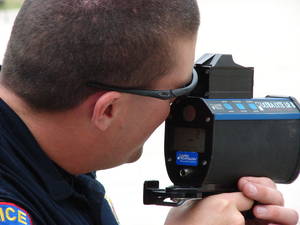 Ben - Aircrafts requires some very tight tolerance manufacturing. What you'll see people in the aircraft industry using laser trackers for example, would be for measuring the alignment of hinge units on the trailing edge of aircraft wings. For example, hinge units for the flaps. You might find people crawling all over the wing surface, measuring the aerodynamic profile because that can be quite important especially close to the aircraft body.
Ben - Aircrafts requires some very tight tolerance manufacturing. What you'll see people in the aircraft industry using laser trackers for example, would be for measuring the alignment of hinge units on the trailing edge of aircraft wings. For example, hinge units for the flaps. You might find people crawling all over the wing surface, measuring the aerodynamic profile because that can be quite important especially close to the aircraft body.
Meera - That's quite an interesting image, just seeing someone all over a wing, holding this very small ball to accurate measure it.
Ben - It's bizarre when you sit and watch somebody doing it because they appear to be cleaning the wing whereas in fact, they're making very precise measurements.
Meera - And what other industries could it be used in? What are other applications of this method?
Ben - The space industry uses them, for example, for aligning components on satellites. It's very critical to get the mass distribution correct to align thrusters through the centre of mass of the spacecraft so that when they fire, it doesn't spin off into infinity, so any area where you're making big things that require very high accuracy.
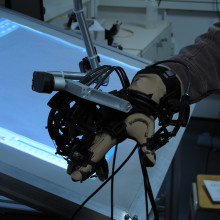
38:47 - Using a Laser as Tweezers
Using a Laser as Tweezers
with Dr. David Carberry, University of Bristol
Ben - Now one of the many new applications of lasers is in the building of tiny, tiny machines. A small device that builds a smaller device, and so on, down to atomic level was a dream of Nobel Prize winning physicist, Richard Feynman and he inspired many researchers to try and find a way. Now, when handling tiny objects, you need tiny tools, and lasers make very good tweezers. To find out how they work, I went to Bristol University and met Physicist, Dr. David Carberry.
David - The goal of our research was to follow Feynman's dream. So this is where you've got a large machine that makes a smaller machine, that makes a smaller machine, until eventually, you can control individual atoms. We're not quite near that stage yet. But we're at the stage where we can definitely build a microscopic machine. We're currently using a large machine that uses a focused laser beam to manipulate small particles around.
Ben - So in order to realize your dream, you need to be able to manipulate things on a tiny, tiny scale, and you're actually using light beams as if they were tweezers?
David - That's absolutely correct.
Ben - Surely, tweezers have to be something - somewhat more solid than light?
David - It really is a focused beam of light. Imagine you've got a glass sphere sitting in 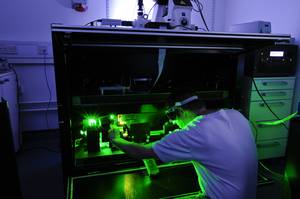 front of you. If you shine a laser beam through that, it will bend towards the centre. This means there has been a change in momentum, which has to have been transferred to the glass sphere. In the case of the glass sphere that you can hold in your hand, the amount of momentum transfer, you can't detect, but in the case of something very small, around the size of a red blood cell, then this has a very large profound effect. It moves into the focus of the laser beam and this is an optical trap or an optical tweezer.
front of you. If you shine a laser beam through that, it will bend towards the centre. This means there has been a change in momentum, which has to have been transferred to the glass sphere. In the case of the glass sphere that you can hold in your hand, the amount of momentum transfer, you can't detect, but in the case of something very small, around the size of a red blood cell, then this has a very large profound effect. It moves into the focus of the laser beam and this is an optical trap or an optical tweezer.
Ben - So the system you have, the holographic optical tweezers, how do they work? Where do you start with that?
David - The simplest way is to have a laser beam that is passed straight into a microscope. It goes through a very high objective lens, so very high numerical aperture, very high magnification, then you form an optical trap if the laser is strong enough. You typically need around 50 milliwatts for the base optical trap. To give an indication of how strong the magnification needs to be, you've got a 100 times objective lens which focuses a 5 millimetre laser beam at a distance of about 100 microns or the thickness of one hair. It's very tightly focused. But this is absolutely required to form a sharp enough laser gradient to hold a particle at the laser focus.
Ben - So you can very tightly focus a laser which means that you can hold something in what you call an optical trap. But in order to construct things, surely you need to bring more than one thing together, so you'd need more than one laser?
David - That's right. But we don't strictly need more than one laser. If we use a hologram, we can break one laser beam up into several outgoing parts and we can control the pattern of the light that comes off that. So, as the laser reflects, it interferes with itself just like you'll see at the beach, the waves will interfere with each other, and this, we can then use to reconstruct several laser beams in the focus of our objective.
Ben - Well that sounds really incredible, but also very complicated. How on earth do you actually control it? How do you do the physical work of bringing two things together?
David - We've got a number of methods. The first one is a simple one. You've got a 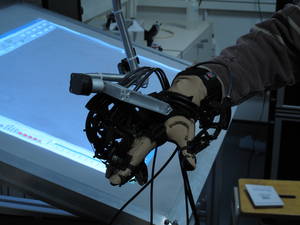 couple of points on the screen with a mouse and you click on the optical trap you want and you move it closer to another optical trap. There's another one where we've got special gloves that you can put on, you can move your fingers closer together, and you can move this around the screen, and you can move the particles closer together. But our most recent thing, we've got a touch screen that we can touch with multiple fingers. Wherever we put our fingers, we form an optical trap, and we can manipulate this in real time, and we can start assembling, we can start whatever we choose to do.
couple of points on the screen with a mouse and you click on the optical trap you want and you move it closer to another optical trap. There's another one where we've got special gloves that you can put on, you can move your fingers closer together, and you can move this around the screen, and you can move the particles closer together. But our most recent thing, we've got a touch screen that we can touch with multiple fingers. Wherever we put our fingers, we form an optical trap, and we can manipulate this in real time, and we can start assembling, we can start whatever we choose to do.
Ben - Could I have a go? It sounds like something that you don't need much training for.
David - I can teach you all you need to know within 30 seconds using this multi-touch. Let's give it a shot.
Ben - At this point, David showed me into the laser room. The holographic assembler itself is housed in a large box as the lasers are powerful enough to cause permanent eye damage. On the top of the box is a microscope with a camera focused on the tiny glass beads that the laser can move. The feed from this camera is then fed through to a computer where you can interact with the beads in real time.
David - This is our multi-touch table where if you stick your finger on it, you will be able to manipulate the glass sphere that is sitting on the screen.
Ben - So does that mean that while I'm pressing on here and moving my finger around, I'm actually dragging around a tiny glass sphere over there on the microscope.
David - That's exactly correct.
Ben - And how big are these?
David - These are about 2 microns, so about a third the size of a red blood cell, but let's put this into perspective. One of these is 50 times smaller than the width of a human hair.
Ben - So these really are tiny. What's the next stage? What do you hope to develop next?
David - The next stage is to develop a few more applications. We're currently looking at two different projects. We're trying to make some nano tools. If we use a nano rod, with two of these glass spheres, we can stick it together and form a kind of pointy stick that we can poke very hard into another object. So we could start feeling the forces on a cell as we poke it.
Ben - And that would be able to tell us things like how strong the membrane of a cell is and I assume this is something that we've just never really been able to measure before.
David - We have been able to measure using the atomic force microscope, but that assumes that it's sitting on the surface and this isn't always the case. Sometimes you've got cells that are floating around in solution and you want to be able to test these in the natural environment, so you don't want to stick them down.
Ben - Let's see the videos of some of the things you have been able to build. What's this? It's very pretty and it seems to be a series of connected rings, almost like the Olympic logo over and over again.
David - That's right, but instead of being just rings, these are actually these glass spheres we've just been manipulating on the screen. In nature, if you start assembling these, or you leave it to gravity, they will form a close packed structure and you've probably all seen this with a pile of beer cans. You stack them all up and they all fit into each other's cavities. Now it's the same with all balls. You can set them the same sort of way, but what I've got on screen is I've deliberately omitted a particular line of these so if you've got your stack of cans, we've now deliberately taken out one particular line, and if we shine a laser beam through here with different frequencies, some laser light will get reflected, some will transmit through, and some will go round the corner, and this is a photonic crystal.
Ben - So because we have a gap in the middle of this collection of glass beads, you get some very particular interactions with light. What's this useful for?
David - In the past, we had something very similar with electronics and we ended up forming the transistor. Now this has gone on to revolutionise the electronics industry. We're hoping that a photonic switch like this will go on and revolutionise the next generation of device.
Ben - Dr. David Carberry from Bristol University on how optical tweezers can be used to build transistors for light and nano tools to study cells.
Could a laser be used to remove graffiti?
We posed this question to Graeme Hirst from the STFC Central Laser Facility...
Graeme: - Yes it can. They're already used in this application, certainly for cleaning expensive things. The trick is to choose a laser so that the colour of the laser light matches the colour of the graffiti ink. [that can then be used to heat the graffiti ink, and blow it off the wall without heating the wall up.] So, yes, it's a very neat solution for cleaning dirty stuff off expensive things. Unfortunately, it's not always cheap and you do have to make sure there's no one around. Ben: - Is it also true that you can use lasers to have a look through the paint and try, and find fraud in paintings? Graeme: - Yes, you can. Again, you choose the right colour. Now, what you're looking to do is to choose a colour which is not absorbed by the top layer of paint so it goes straight through. It'll be absorbed by something a bit lower down, it'll bounce back off that and whether it's there or not, you will get bounce-back or not and by mapping out the bounce-back, you can look at the layer below the paint layer.
Can lasers be harmful?
We posed this question to Graham Hirst from the STFC Central Laser Facility...
Graeme - Well some do. It's not just true of laser light. In fact, you'll know that if you got one of those really, really powerful torches, you're warned not to put your hand directly in front of it, it will also be giving off a lot of heat. That really reflects the fact that heat - in the form of thermal radiation - and light are just the same sort of stuff. If you like, light goes blue, green, yellow, orange, red, infrared, heat. You can get lasers that work in the heat part of the spectrum as well. Some of them have very long wavelength indeed, cutting and welding lasers for instance will put out 10,000 watts of heat at the most powerful end.
With the best laser, how small a spot could you focus from earth to the moon?
We posed this question to Graeme Hirst from the STFC Central Laser Facility...
Graeme - You're trying to fight a thing called diffraction and that depends on how big you can make your laser beam down at the earth. A back of the envelope calculation - laser light spreads out about one wavelength in 10 metres. It's 400,000 kilometres to the moon. You'll probably get something about 40 metres across [on the moon]. As a football metaphor, we'd be looking at something about twice the size of the 18 yard box.
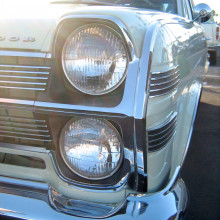
55:42 - How fast does a moving light source go?
How fast does a moving light source go?
We posed this question to Dominic Ford from the University of Cambridge...
Dominic: - I'm Dominic Ford from the department of physics at Cambridge. You've probably had the experience at some point that a fire engine has driven past you and as the fire engine has been driving towards you, you've heard it sound high pitched. And as it's driven away from you, you've heard it sound low pitched. That happens because sound is a wave and the Doppler effect says that the frequency has changed when you are moving relative to the source of the sound.
Now light is also a wave and so, it also shows the Doppler effect. But you have to be travelling very much faster before you see any effect. So if you were driving your car at close to the speed of light, an external observer would see that your front headlights would appear more blue than normal and your rear taillights would appear more red than normal. The driver himself wouldn't actually see anything different from normal because he's not moving relative to the source of the light. Just as the driver of a fire engine hears his siren at a constant pitch because he's not moving relative to the siren. Looking out the window though, the driver would be moving relative to any landscape that he was moving past, and he would see objects in front of him appear bluer than normal and objects behind him appearing redder than normal.
Of course if things move very much faster, for example, a plane moving at close to the speed of sound, you get a sonic boom, and you get a similar effect with light. But unfortunately, Einstein's theory of special relativity says that you need infinite energy to make something move at the speed of light. And so, you can never actually get there and observe that effect.
There is one exception which is when a relativistic particle travels in a material like glass in which light travels at slightly less the speed of light - sounds ironic, but it's true! When the particle produces some radiation called Cherenkov radiation, which appears as a flash of light, the visual equivalent of a sonic boom. Diana: - To the driver, if he or she had infinite energy and hadn't imploded by then, the lights would look perfectly normal. To an observer, there would be a colour shift with blue headlights and red tail lights becoming more red if that's possible. And objects which do move faster than the speed of light will produce this Cherenkov effect, the sonic boom of the light world, and you can see it as a blue glow in some nuclear reactor chambers.
- Previous Sharks, Sleep and Soccer
- Next How Did HIV Begin?
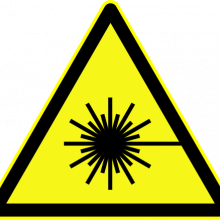









Comments
Add a comment